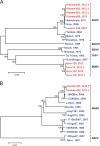Genomic analysis of filoviruses associated with four viral hemorrhagic fever outbreaks in Uganda and the Democratic Republic of the Congo in 2012
- PMID: 23711383
- PMCID: PMC5695039
- DOI: 10.1016/j.virol.2013.04.014
Genomic analysis of filoviruses associated with four viral hemorrhagic fever outbreaks in Uganda and the Democratic Republic of the Congo in 2012
Abstract
In 2012, an unprecedented number of four distinct, partially overlapping filovirus-associated viral hemorrhagic fever outbreaks were detected in equatorial Africa. Analysis of complete virus genome sequences confirmed the reemergence of Sudan virus and Marburg virus in Uganda, and the first emergence of Bundibugyo virus in the Democratic Republic of the Congo.
Published by Elsevier Inc.
Figures


References
-
- Hartman AL, Towner JS, Nichol ST. Ebola and Marburg hemorrhagic fever. Clin. Lab. Med. 2010;30(1):161–177. - PubMed
-
- Leroy EM, Kumulungui B, Pourrut X, Rouquet P, Hassanin A, Yaba P, et al. Fruit bats as reservoirs of Ebola virus. Nature. 2005;438(7068):575–5761. 438 (7068) 575–576. - PubMed
-
- MacNeil A, Farnon EC, Morgan OW, Gould P, Boehmer TK, Blaney DD, et al. Filovirus outbreak detection and surveillance: lessons from Bundibugyo. J. Infect. Dis. 2011;204(Suppl 3):S761–S767. - PubMed
-
- Pourrut X, Delicat A, Rollin PE, Ksiazek TG, Gonzalez JP, Leroy EM. Spatial and temporal patterns of Zaire ebolavirus antibody prevalence in the possible reservoir bat species. J. Infect. Dis. 2007;196(Suppl 2):S176–S183. - PubMed
MeSH terms
Substances
Associated data
- Actions
- Actions
- Actions
- Actions
- Actions
- Actions
- Actions
- Actions
- Actions
- Actions
- Actions
Grants and funding
LinkOut - more resources
Full Text Sources
Other Literature Sources
Medical
Molecular Biology Databases

